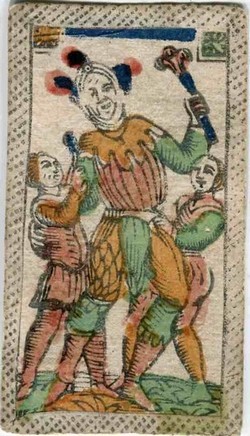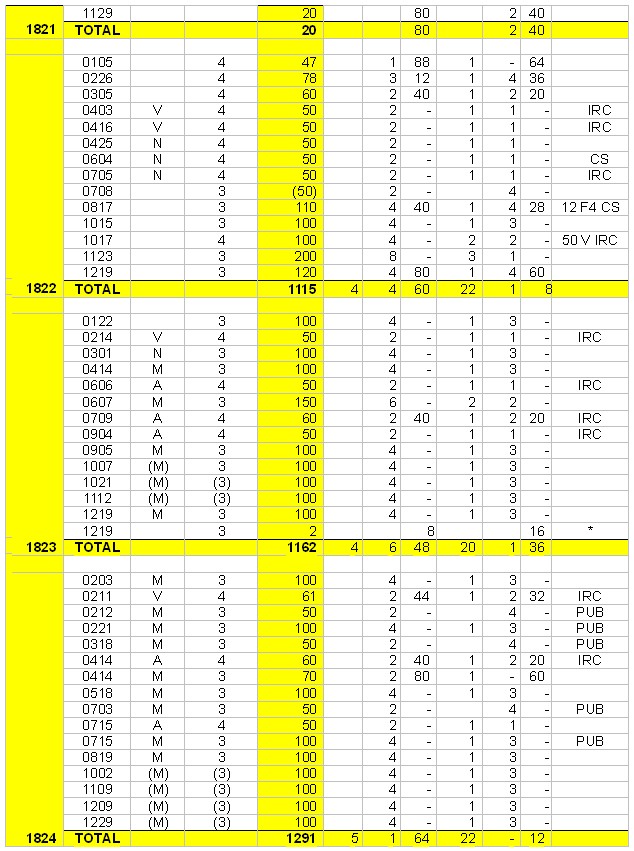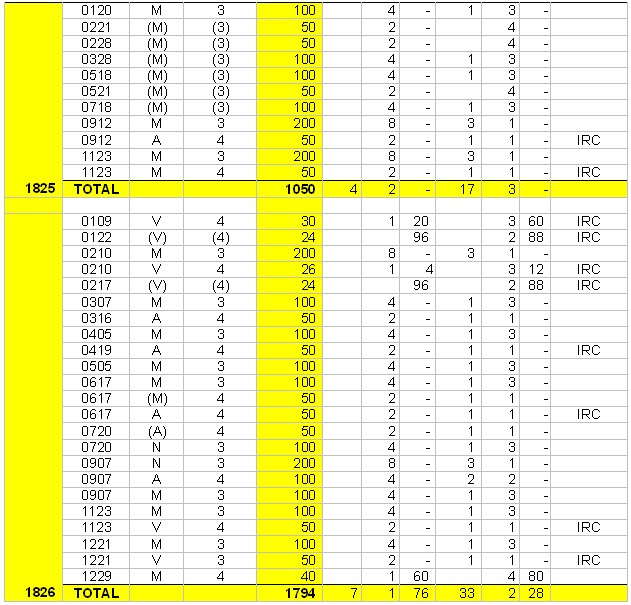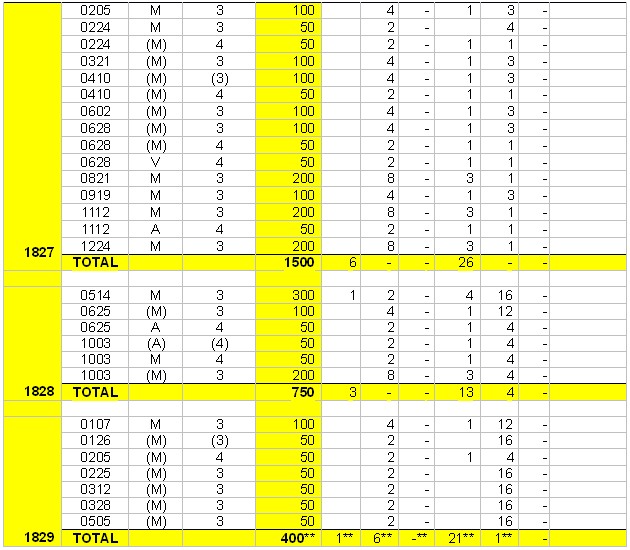INTRODUCTION
The new information reported in this note comes again from the archive group “Amministrazione del Registro e delle Aziende riunite”, kept in the Archivio di Stato di Firenze. Whereas dozens of registers of this group had been examined for a previous note,(1) only a very thin one has been studied in this case.
It contains records of the production of Minchiate by cardmaker Giuseppe Berrettari, and the information provided is very interesting, even though several details remain rather puzzling and demand a little discussion.
1. THE NEW INFORMATION
1.1 - The register
All the new information reported and discussed in this note is obtained from one and only one thin register of Minchiate production.(2) This register belongs to the part of the archive group coming from the Siena direction of the “Amministrazione del Registro e Aziende riunite”. It does not belong to a sequence of similar registers, is catalogued as No. 692, and is the very last item of the whole Siena section.
The dimensions of the cardboard cover and of the first paper sheet (namely, of the first and last two pages) are 21x32 cm, whereas all the inner pages have been cut at the top by 3.5 cm, so that the heading of the external pages is used for all the inner ones.
There are twenty folios in the register, but only eleven have been written. We have on the left page the Dare entries, while on the right page we find the corresponding Avere ones. This is a usual way to keep ledgers and cash books, in which debits and credits are recorded as parallel text; in this case, however, we do not find money accounts of incomes and expenses. What comes in are paper sheets (with the indication of card packs that should be obtained with them), what comes out are card packs (with the indication of paper sheets used for making them).
I have summarised in the table below all the contents of the eleven pages of Avere, whereas I have used the left pages of the register, Dare, only for deducing some additional detail.
1.2 – Il Fabbricante
Already the title of the register, “Riscontro del Fabbricante di Carte da Giuoco”, may offer an essential information, because it deals with Giuseppe Berrettari, “the” cardmaker, instead of one of the cardmakers, as active in Florence for the whole of Tuscany.
Speaking of “the” cardmaker implies that only one was active there, and may thus provide an independent indication that Berrettari was by then active in Siena instead of Florence, where he had been found at work earlier on, in his workshop of Via Condotta.(1)
1.3 – Il Revisore
The counts recorded are signed. Each entry has in the margin an autograph confirmation by Berrettari, with his signature. The register is written, or at listed verified and signed, by Giovanni Andrea Pescetti as Revisore, or auditor. His position and signature are present in the first page of the register.
Now, Pescetti was active as a public servant in the Florentine Ufficio del registro. As for “the” Fabbricante, here too we can speak of “the” Revisore. As a matter of fact, it was precisely Pescetti who was in charge for many years, before and after the dates encountered in this register, of the control of the playing card production. His job included several tasks, such as bookkeeping and inspecting the workshops of the makers, verifying the stock accounts, and the matching between watermarked sheets and packs produced.
In the Florentine registers, we find him as the responsible of all these controls in Florence, and in Leghorn too. (Never could I find him active in Siena for his job, see the following discussion.)
1.4 - Time interval
We can be reasonably certain that this workshop of Berrettari was different from that located in Via Condotta in Florence, where he was active precisely up to 1821;(1) thus, 1821 is a reasonable time for the beginning of a new activity, possibly in a new place.
On the other hand, we find a definite information, in the register itself, on the end of the new activity documented here, as imposed by a Sovrano Motu Proprio of 15 April 1829. The last entry in the register, in folio 11 left, is dated 17 May 1829.
1.5 - Minchiate packs produced
As mentioned above, alongside of the packs produced we find the indication of the paper sheets needed, and some further information, which is reported together in the table below and will be discussed in the following sections.
| STILL IN WORK
Provisional Installation

|
|
1.6 - Amount of Minchiate
What has been the most surprising data of them all has been to my mind the amount of packs produced by Berrettari. This cardmaker made here an approximate average of one thousand Minchiate packs per year, in the course of nine years, slightly more than nine thousand packs in all; 9082, if I have summed them up correctly.
This is a huge amount, if related to a practically unknown maker, working in a little defined place. Noteworthy is that in the four years, 1818-21, in which his activity in Florence is documented,(1) he only produced about sixty Minchiate packs per year.
The packs produced must be related with the packs found in the hands of the players. Now, we have in a previous note(1) the total number of Minchiate produced and stamped in those same years by all cardmakers active in Florence, who worked for the whole market of Tuscany.
Surprising enough, the total number of Minchiate produced in Florence by all the five cardmakers active at the time was of the same order of magnitude than that produced in an unknown workshop by this minor cardmaker, as Berrettari certainly was.
This comparison will require some ad hoc assumption to be explained, or tried to be explained. Seemingly the stamping taxes have a part in the question.
2. OPEN QUESTIONS
2.1 - Siena?
In spite of a careful reading of the whole contents of this register, I found no hint there about the location of Berrettari’s workshop. What is certain is that – wherever the location – he worked under the control of the Florentine administration, with Pescetti as Revisore. On the other hand, since 1821 he was no longer present among the Florentine cardmakers, even though he had worked there for a few years earlier on, as documented in a previous note already quoted.(1)
Now, the cards produced for the whole of Tuscany were made by cardmakers active in Florence, with rare exception, such as Lucca (which mostly was independent of Tuscany),(3) or Leghorn, where we found Maury active under the Florentine control in the years around 1820.(1)
Siena had however some special relation with the Florentine Ufficio del Bollo. It suffices to remember the “export” of playing cards to Siena that was managed in the 19th century by Molinelli,(4) because the cards used in Siena territory were not stamped in Florence.
It is possible that for a few years the administration allowed a local production of playing cards in Siena, with the same accurate control, but without submitting the products to the usual stamping taxes. Another possibility is that a change occurred in Berrettari’s contract for producing Minchiate in Florence (where Pescetti’s control could be easier, and more efficient), however under conditions different from the other cardmakers – to begin again with stamps and taxes.
2.2 - Ordinary cards?
It may be surprising, as for other puzzles in this context, that only Minchiate are recorded as produced. We are thus left with the question whether Berrettari produced no cards more than Minchiate.
When his production is recorded in Florence, a few years before, he made ordinary cards as well, and in amounts significantly larger than Minchiate. Now, it seems more reasonable to imagine at the time a cardmaker producing several kinds of playing cards, without making any Minchiate, than vice versa a cardmaker who produced only Minchiate and no ordinary cards.
In order to match the last hypothesis, some specific reason should have been present: for instance that the administration had allowed the production of Minchiate and forbidden that of ordinary cards. Or the production of other cards was simply recorded in different registers, no longer present together.
2.3 - Various patterns?
It is certain that the Minchiate packs produced by Berrettari did not correspond to a single traditional pattern. What is somewhat puzzling here, too, is that we find no less than four different attributes to the technical term of Stampa e Miniatura (with Impronta sometimes used instead of Stampa, with the same cumulative meaning of printing and painting) for the Minchiate varieties produced: Antica, Vecchia, Moderna, Nuova. These four attributes, when present, I have kept in my copy of the records in the table, indicating them with their initial letter.
However, I suppose that there existed only two different kinds of products, the old pattern, indicated as either Antica or Vecchia, and the new pattern, indicated as either Moderna or Nuova. Needless to say, this appears as a plausible interpretation, even though it cannot be considered as a hundred per cent certain.
2.4 - Risma, Mano, Foglio?
For indicating the quantity of paper used, we find three different units of measure. The three Italian words for them are all common terms, even if finding the meaning of “Mano” in this context requires a very big dictionary, or a specialist. It may be better to translate it as “quire”, instead of with its usual “hand” meaning.(5)
The name of Foglio is a fortunate exception, because it does not cause any problem here; it is just one sheet of paper, the smallest possible unit.
Risma, a ream, at the other end, is now practically everywhere standardized as the bundle of 500 sheets that has become very familiar to everybody after the universal spread of printers and copying machines. However, the preferred amounts of sheets in one ream have been various in the course of time, with 480 as a current value.(5) What lets this question harder to determine is that in these very records we find the same Risma term applied to bundles of either 1000 or 500 sheets, depending on the paper quality.
Mano, the intermediate unit, is not standardised too. According to the big Treccani dictionary (6) it should correspond either to the twentieth or the hundredth part of a common ream of 500 sheets, thus to either 25 or 5 sheets.
Here, it corresponds for watermarked paper to 100 sheets, or one tenth of a ream. In this case, the reading is very easy: if we find 1.2.34 in the R.M.F units used, this merely corresponds to 1234 sheets. For plain paper, the situation is different: one Mano seems again to correspond to 100 sheets, but is thus now one fifth of a ream of that paper.
2.5 - Three or four paper sheets?
In correspondence with almost every entry we find the additional property mentioned whether the card pack in question was made using three or four sheets of paper. When this information is not explicitly provided, it can be deduced from the expression “come sopra”, as above, as for the previous entry. These last cases I have indicated repeating the quality of the previous entry within brackets.
As a matter of fact, passing from four to three sheets for the production of the same number of 97 cards appears as a big jump, and a three fourths reduction in the dimension of the 97 cards is not acceptable. Moreover, when we examine the number of watermarked paper sheets – affirmed in the this register to have been used for the production of a Minchiate pack - we find four everywhere, independent of the parallel statement that either three or four Fogli had been used.
The only plausible hypothesis that remains is that these “sheets” were the layers that formed each card. In other words, the same term of Foglio appears to have been used in the register with two different meanings, either the whole sheet of paper, or its much smaller part used in every card. This is confirmed by the additional expression that we usually find recorded together, “compreso il figurato”, included the sheet with figures.
We thus simply had either one or two intermediate sheets between the front and the back one. Apparently, the old habit was to use two intermediate sheets in the traditional cards, whereas only one was generally inserted in those with the new pattern.
2.6 - Paper
Very useful and complete is the information on the kind of paper used in the card production. This is better found in the part of the register that I did not copy, all the eleven pages on the left side, corresponding to the debits (instead of the credits reported on the pages on the right and summarised in the table).
The paper sheets used belonged to two kinds, watermarked and plain. For the watermarked paper we have no difficulty in associating the number of packs to one fourth of the number of sheets, in a ream containing 1000 sheets as discussed above. If anybody is here in search of a problem, it may be found in the association of the card figures with these sheets, which could only be identical if taken in groups of four, containing all the figures printed.
The sheets of plain paper in their turn were not identical - except that there were only 500 of them in one ream. There were two different kinds of paper, coloured and white.
The coloured sheets provided were of two kinds, red or deep blue – about in the same amount. These sheets were intended for the backs of the Minchiate cards. We usually find the word “punteggio” associated with these sheets, apparently suggesting that they were dotted. It is not well defined if they were already dotted at the origin, or the cardmaker cared for it – the former hypothesis seeming more likely.
For the white paper provided together, it is not clear-cut which was its fraction, and how the exact use of the sheets could be controlled in this case. Actually, this kind of paper was addressed to various uses.
First of all, they were needed for “rinforzo” and/or “ripieno”, strengthening and filling; namely, for the intermediate layers of the cards. Sometimes this paper is mentioned as Fioretto, a technical term for low grade quality. Another use was for “involti”, or for wrapping the complete packs up.
In a few cases, we read Carta scura, or dark paper, which seems to have been an alternative to the common red or dark blue sheets for the backs.
2.7 - Cards for the Imperial and Royal Court
It is certain that the main task of the Ufficio del Bollo of Tuscany was the control of the stamps on all the playing cards to be used in the country. Here, we find no mention of stamps. On the contrary, we find a clear evidence that these cards were not stamped at all.
In several cases, and especially in correspondence with the old-fashioned Minchiate, we find explicitly indicated that they were addressed to the “Imperiale e Regia Corte”, with the Imperial and Royal attribute to the Court clearly echoing the renowned German “k.u.k” acronym, commonly associated with the Vienna rulers.
The number of packs addressed to the Court was not negligible. Moreover, in several other cases, it is possible that the identical destination was simply neglected in the records. Now, if card packs had to be used by the Court, who may venture to insinuate that those personages had to use stamped cards and to pay the corresponding taxes?
It is possible to suppose that having an autonomous source of unstamped cards could be useful to protect the privacy of people who could enjoy their use, including the members of the court; of course, all of them had to belong to the high classes.
2.8 - Cards for the public
Another question is whether the Minchiate made by Berrettari could be addressed to a wider market than the Court. Actually, only for a few entries we find an explicit statement that the packs in question had the Pubblico as their destination. If one considers the high number of packs produced, there is no problem in accepting that a part of them were made for the common people. On the contrary, we can easily suppose that more entries had this character, even when it was not explicitly indicated.
What is to understand here is how these packs could be used, if they had to be stamped subsequently or if they had to be used in places where paying the taxes required by the Florentine Ufficio was not necessary.
CONCLUSION
A completely unknown, and unexpected, production of Minchiate in the years 1821-1829 is documented with valuable detail in a register kept in the ASF and first described here.
The amount of packs produced by an individual cardmaker is of the same order of magnitude as the whole production of Minchiate packs recorded for all the other cardmakers active in Florence at the time.
In spite of the richness of the information, several open questions remain, which have been individually discussed in the present note.
Footnotes:
(1) Franco Pratesi: 1815-1861: THE PRODUCTION OF PLAYING CARDS IN TUSCANY (2013)
(2) ASF, Amministrazione del Registro e Aziende riunite. Direzione di Siena. N. 692.
(3) Franco Pratesi: 1810-1811 – PLAYING CARDS IN LUCCA (2013)
(4) Franco Pratesi: 1729-1762: EXPORTS OF FLORENTINE MINCHIATE (2013)
(5) Wikipedia: Units of paper quantity
(6) Treccani.it: "Mano" Entry No. 6. = "La ventesima parte di una risma di carta, corrispondente a 25 fogli, oppure la centesima parte, corrispondente a 5 fogli (detta anche mazzetta)".
| STILL IN WORK
Provisional Installation

|
|






